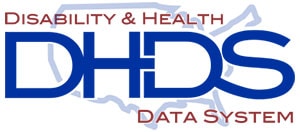Disability and Health Data Now

There are important health differences between people with and without disabilities. Do you know what they are in your state or territory? The Disability and Health Data System (DHDS) can help you find out.
Disability doesn’t have to equal poor health. However, adults with disabilities are more likely to be obese,1 smoke,2 have high blood pressure,3 and be physically inactive.4 These are all preventable factors that can increase the risk for chronic diseases such as heart disease, stroke, diabetes, and some cancers,4-6 which are also more common among adults with disabilities.7
CDC created the Disability and Health Data System (DHDS) to provide the vital information needed to better understand the health needs of adults with disabilities at the state and national levels. Equipped with these data, state and territorial epidemiologists, researchers, policy makers, public health professionals and everyone interested in the health of adults with disabilities can plan for inclusive communities that offer the programs and services needed to improve the health of this population.
What Do We Currently Know About Disability and Health?
- Disabilities are common, with more than a quarter of American adults reporting a functional disability.
- Disability is not a health outcome; it is part of the way people experience life, such as hearing, seeing, moving, processing information, and caring for oneself. People with disabilities are a large part of every community and population. Many of us know, or are, someone with a disability, and disability inclusion is beneficial for all.
- People with disabilities experience health disparities and are more likely to report certain health conditions. DHDS is a tool to help raise awareness of health disparities experienced by people with disabilities. DHDS data can inform program and policy initiatives aimed at improving the health of people with disabilities.
What Are the Key Findings from the New Data?
- According to 2022 Behavioral Risk Factor Surveillance System (BRFSS) data now reported in DHDS, more than a quarter of adults in the United States (28.7%) report having a functional disability. That means an estimated 70 million Americans navigate daily life with challenges in hearing, vision, mobility, cognition, self-care, or independent living.
- For the first time, the 2022 BRFSS collected data on respondent experiences with Long COVID. Long COVID was reported to be more prevalent in people with disabilities (10.8%) than in people without disabilities (6.6%).
- More people reported serious difficulty with remembering, concentrating, and making decisions (i.e., cognitive functioning) than in the previous year (13.9% in 2022 compared to 12.8% in 2021).
- Consistent with earlier years, older adults reported the highest disability prevalence (43.9% of people aged 65+ years). The longer we live, the more likely we are to experience disability due to a health condition or injury. This is often heightened by reduced social and community engagement as we age.
- While disability is most common in older adults, more younger adults (aged 18-44 years) reported disability in 2022 (23.6%) than in the year prior (21.2%).
- People with disabilities experience health disparities and are more likely to report certain health conditions. For example, in 2022, 43.6% of people with disabilities reported experiencing depression compared to 13.7% of people without disabilities.
Together with our partners, CDC works across public health disciplines to improve disability inclusion and considerations in ongoing data monitoring systems, disease prevention and health promotion programs, and emergency preparedness and response efforts.
DHDS is
- Interactive—An online, easy-to-use data tool that provides state- and national-level data on approximately 30 health topics for adults with disabilities.
- Customizable—You can explore data by indicator (e.g., health topic) or by location, then customize maps, charts, and tables, making it easy to view information for your state or territory.
Data Available in DHDS
DHDS includes analyzed BRFSS data from 2016–2022 on
- Disability estimates
- *Disability status (any disability or no disability) and disability types (hearing, vision, mobility, cognition, self-care, and independent living) overall; and
- By age, sex, race/ethnicity, veteran status.
*Respondents were defined as having any disability if they reported serious difficulty hearing or deafness (hearing disability); serious difficulty seeing or blindness (vision disability); serious difficulty walking or climbing stairs (mobility disability); serious difficulty concentrating, remembering, or making decisions (cognitive disability); difficulty dressing or bathing (self-care disability); or difficulty doing errands alone (independent living disability).
- Demographics among adults with and without disabilities and by disability types
- Income level;
- Education level;
- Marital status;
- Employment status; and
- Urban/rural residence.
- Approximately 30 health topics among adults with and without disabilities and by disability types, including
- Smoking;
- Obesity;
- Heart disease;
- Diabetes;
- Long COVID;
- Binge drinking;
- Flu vaccine; and
- Healthcare coverage.
With DHDS, you can answer questions, such as
- What is the percentage of adults with a reported functional disability in my state or territory?
- How does this population vary by age, sex, and race/ethnicity?
- How does my state compare with other states and the nation?
- How does the prevalence of depression, diabetes, obesity, or smoking vary among people with select disability types?
CDC’s Partners and State Programs are Using DHDS
You Can Use DHDS to

Use DHDS to help improve the health and the well-being of adults with disabilities in your state.
Get started now!
Visit DHDS at https://dhds.cdc.gov.
- Identify health differences between adults with and without disabilities overall and by age, sex, race/ethnicity, and urban/rural residence;
- Download data for use in presentations, reports, or fact sheets;
- Inform partners, policymakers, and communities about the health of adults with select functional disability types; and
- Make the case for the inclusion of people with disabilities in community programs and services needed to improve their health.
Disability & Health U.S. State Profiles
CDC also has state and jurisdictional profile fact sheets that provide an overview of disability in each state, the District of Columbia, Guam, Puerto Rico, and the U.S. Virgin Islands, including the percentages and characteristics of adults with and without disabilities. Click on any jurisdiction listed here to view the profile.
- Weil E, Wachterman M, McCarthy EP, et al. Obesity among adults with disabling conditions. JAMA. 2002; 288:1265–1268.
- Courtney-Long E, Stevens A, Caraballo R, Ramon I, Armour BS. Disparities in current cigarette smoking prevalence by type of disability, 2009–2011. Public Health Rep. 2014;129(3):252–60.
- Stevens A, Courtney-Long E, Gillespie C, Armour BS. Hypertension among US adults by disability status and type, National Health and Nutrition Examination Survey, 2001–2010. Prev Chronic Dis. 2014;11:E139.
- Hollis ND et al., Physical activity types among US adults with mobility disability, Behavioral Risk Factor Surveillance System, 2017. Disabil Health J. 2020:100888. https://doi.org/10.1016/j.dhjo.2020.100888
- Department of Health and Human Services (US). The health consequences of smoking: A report of the Surgeon General. Washington: HHS, Centers for Disease Control and Prevention, National Center for Chronic Disease Prevention and Health Promotion, Office on Smoking and Health (US); 2004.
- Chobanian AV, Bakris GL, Black HR, Cushman WC, Green LA, Izzo JLJr, et al. Seventh report of the Joint National Committee on Prevention, Detection, Evaluation, and Treatment of High Blood Pressure. Hypertension. 2003;42(6):1206–52.
- Okoro CA, Hollis ND, Cyrus AC, Griffin-Blake S. Prevalence of disabilities and health care access by disability status and type among adults — United States, 2016. MMWR Morb Mortal Wkly Rep. 2018;67:882–887. DOI: http://dx.doi.org/10.15585/mmwr.mm6732a3External




